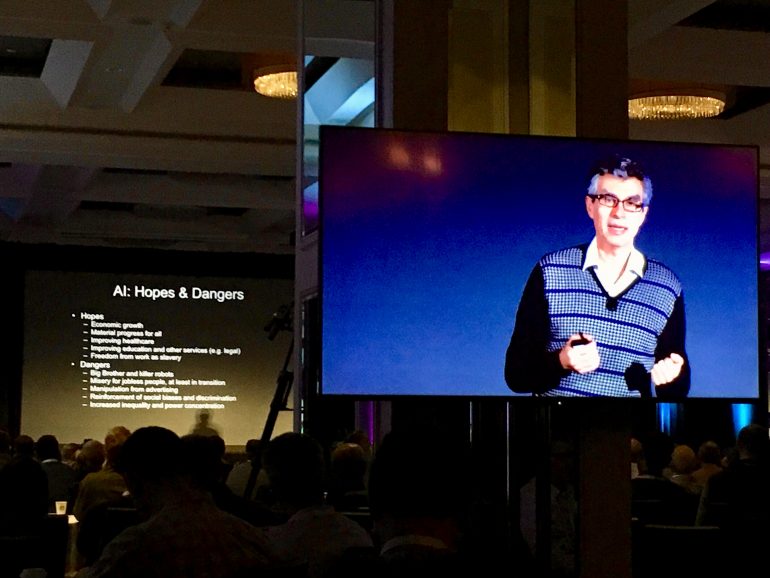Pour lire cet article en français, cliquez ici.
Last week, Activate’s two-day conference on artificial intelligence (AI) included two days of workshops and training. The conference has been taking place for the past eight years in Montreal, and its objective is to bring the best minds in AI together for technical tutorials, use case presentations, and networking sessions. None other than Yoshua Bengio, Canada’s superstar in AI, opened the conference with a keynote speech.
Bengio started by sharing breakthroughs in AI, stating that “computers have made a huge stride in perception,” and that it significantly evolved in terms of language manipulation, in playing games, and in reasoning. For instance, convolutional neural networks (CNN), a kind of deep learning useful for image recognition, exploit the invariance in translations and allows learning of multiple levels of abstraction. In other applications, the ability to abstract enables CNNs to generate images, otherwise known as creative AI.
Making AI human-centric is critical to delivering a positive data experience. #activatesearch #Activate18 @Activate_Conf @GirlFromBlupo pic.twitter.com/CJDVzh9Vkf
— Guy Sperry (@theguysperry) October 17, 2018
In recent years, AI has also made some breakthroughs in the field of robotics, where systems now commonly take advantage of computer vision. We have also seen tremendous progress in neural machine translation that we can now experience in Google Translate.
Bengio took the chance to explain the five key elements for progress in machine learning (ML) and AI. These include: large amounts of data, a very flexible model (“the more data we have the more flexible the solution will be”); enough computing power; powerful priors that can defeat the curse of dimensionality; and computationally efficient inference. “It’s not enough to have knowledge, we have to use it efficiently,” he said.
But what are the actual limitations of AI? Successful industry applications “are mostly based on supervised learning and require lots of human-labelled data implicitly defining relevant high-level abstractions,” which means that human biases are replicated in the system we build using AI and ML.
In addition to this problem, we sometimes build neural networks “learning relatively superficial clues, and sometimes not generalizing well outside of training contexts” which makes it easy to fool trained networks. On top of that, “these systems don’t have an understanding of the world as powerful as ours,” he adds, as humans are skilled at unsupervised learning.
Dr. Yoshua Bengio: Machine learning doesn't mean free lunch #activate18 pic.twitter.com/TtFp9aKuwF
— Diego Ceccarelli (@diegoceccarelli) October 17, 2018
“Even without scientific breakthroughs in the short-term, current ML science can deliver immense value, thanks to larger datasets, better engineering, better hardware for interference, and for training,” Bengio said. For instance, the areas of medicine, factory automation, transportation, agriculture molecule design, personal assistants, translation, speech recognition, and speech synthesis are all progressing quite fast. AI is often seen at the center of the next Industrial Revolution, and data as “the new oil.”
Bengio takes this further. “For an industry, implementing AI is not a question of competitiveness, but a question of survival as the machines are extending humans’ cognitive power, and AI can double growth rates.”
We often hear that Montreal is a leader in AI and that its ecosystem is well developed. It is, in fact, a growing research hub. The Montreal Institute for Learning Algorithms (MILA), has an exceptional concentration of academic researchers in deep learning and the government has invested a great amount of money – $200 million in the last two years alone – contributing to the city’s significant international recognition.
Still, we need to figure out a data strategy, we need talent, and we need a plan on how to leverage current products and services with ML. “The government has a responsibility to think ahead of these changes and introduce skilled programs and changes in the social safety and try to buffer those changes and keep society in good shape,” Bengio said.


